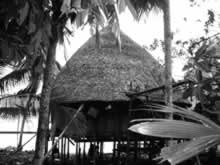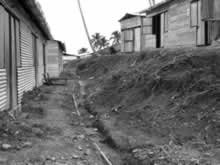•
Write the author
The neglect of the people has its roots going back many decades and is to be located in the isolation of the Islands from mainland India
and the consequent freedom given to the administration to do as they please. Central scrutiny is minimal, few NGOs exist, the national
newspapers find it too expensive to cover the Islands in normal circumstances and the Bar at Port Blair is not accustomed to doing public
interest petitions. All this creates a ripe situation for the exploitation of the tribals who suffer without demur and protest injustices
done to them with amazing politeness.
Before the tsunami, the tribals had their own plantations, were accustomed to fishing and had a certain sense of well being and
self-confidence. Though the balance of power between the administration and the tribals always tilted in favour of the former, the
tribals were often determined to speak their mind and do as they please. The tsunami changed all that. A once proud people are reduced to
living in tin sheds and on the free rations of government. They are shaken and afraid. The administration could have responded to restore
confidence and self-esteem but did just the opposite. They reinforced practices of dependence and subservience.
All that the people wanted in the first days after the tsunami were tools so that they could build their houses with the timber lying
around. The government refused. Instead a hare-brained scheme for providing tin sheds was floated at Delhi and pushed down the throats of
the tribals in the Islands. Tin sheds have been tried and have failed everywhere. And yet in the Islands tens of thousands of these
sheets were ordered and distributed. From the cool confines of their machaans made of wood the tribals were shifted to ovens where
they baked in the afternoon sun. These temporary structures had no flooring and so when the rains came inside, so too did the slush.
Everywhere the tribals protested but they were scared that their criticism of the tin sheds may be seen by the administration negatively
and may result in the withdrawal of benefits. So they suffered the stupid mainlander. But they would ask again and again 'give us
tools'; they were ignored.
•
Vol #4, Issue #3, Combat Law
•
Relief
•
Adivasis
•
Tsunami coverage
•
Printer friendly version
![]() The betrayal of tsunami survivors
The betrayal of tsunami survivors
A blinkered bureaucracy has proved to be utterly insensitive to the
Andaman and Nicobar islanders. Instead of helping them rebuild their lives and revive self-confidence, the
government is reinforcing practices of dependence and subservience while pushing its warped version of relief and
redevelopment, writes
Colin Gonsalves.

Combat Law, Vol. 4, Issue 3 -
Though much has been written about the situation in Tamilnadu and Pondicherry, the conditions of tsunami survivors in the Andaman and
Nicobar Islands is little known. Many NGOs working in the area are collaborating with the administration and are apprehensive about
speaking out. With the arrival of the monsoons, rehabilitation work has become slower. Many journalists covering the Islands budget for a
few days only, spend most of their time at Port Blair, and cannot always make it to the smaller islands. The Human Rights Lawyers Network
team was on the Islands immediately after the tsunami and has maintained a presence there to this day. This is their report of the
betrayal of the tsunami survivors.

![]() Photographs by Sunil Kumar Jojo
Photographs by Sunil Kumar Jojo
 Then and now: The once proud Nicobari people living in their natural habitat have been forced now to live in abominable conditions in
tinsheds.
Then and now: The once proud Nicobari people living in their natural habitat have been forced now to live in abominable conditions in
tinsheds.

Instead what do we have? As long after the tsunami as May 2005, when we visited the Islands, we found even the temporary shelters incomplete everywhere, and the tribals leaving their homes and going into the forest areas in the afternoons to escape the heat of the tin sheds. And as we were leaving the monsoons first showers came in, making the houses unliveable.
Then we learned that someone at Delhi has taken a decision to build pre-fabricated houses, either of reinforced cement concrete or a steel tubular structure, as permanent housing in the Andamans. The salinity of the air will cause the RCC structures to corrode and the tubular structures to rust. The tribals will not be able to maintain these houses and repair them, having no skills to do so. If this dubious plan works, the whole Andaman and Nicobar Islands will be converted into a giant concrete slum. There are officials overanxious to push this plan through, going from island to island and village to village giving the people three plans to chose from: all RCC or steel but not wood, giving the people the impression that they either accept that or they will get nothing at all.
And then casually, almost as if by chance, we heard from the mouth of a senior administration officer that the free rations will be discontinued from October. There can be no greater injustice than this. The lives of the tribals have been shattered, their communities splintered, their livelihood destroyed, their homes washed away and, in these circumstances, all that they have, in the name of a little bit of security, is their free rations. They have no boats so they cannot fish. Free grains is what they depend on to survive. What we would like to know is: Who has taken the decision to discontinue the provision of free grains and why are the people not being told about this decision?
We found water shortages everywhere. People were drinking contaminated water. Children were falling sick. Truly no one cares for the little children. In the six months since the tsunami, apart from a few sporadic attempts, their education came to a standstill, with the State not bothering to supply text books and note books. Had that elementary thing been done, the teachers in the villages would have ensured that the students not lose any time.
Many villages were in darkness. Where the electricity lines were up and the generators in place there was no kerosene. In some places public transportation was at a standstill and people had to walk long distances to reach their villages.
It is pathetic to see the manner in which the people travel from island to island and that too in the Andamans which houses a large and sophisticated naval base. The ships have no fixed timings. When they sail they carry passengers many times their capacity with people huddled on deck like cattle. The toilets are stinking and overflowing. Sometimes for days the people wait.
Like the demand for tools we heard the demand for boats everywhere. Like the demand for tools this was also something that would restore self-confidence and a sense of self-worth. The people would fish. They would travel from island to island carrying their vegetables and doing some trade. Independence, morale and self-confidence of the tribal people must be a priority.
Where has all the money gone? Ask an official, and he will give you a lump sum figure. Ask another and he will give you an entirely different sum. Why is it that the Government of India refuses to put up on a website or publish in a newspaper the list of beneficiaries with the amounts donated? There is strong resistance to this in the administration. It is not the business of the NGOs to ask such questions, we were told in a meeting. Large sums of money exist and must be used for the purpose it was intended for. A CAG inquiry may be of some use. But there is no excuse for a government, committed to the Right to Information, not to disclose to the public at large details of the money received and precise details as to how it is being spent. The greatest justification for this is the fact that on the ground the tribals suffer deprivation and ill health.
It is pathetic to see the manner in which the people travel from island to island and that too in the Andamans which houses a large and
sophisticated naval base. The ships have no fixed timings. When they sail they carry passengers many times their capacity with people
huddled on deck like cattle.
![]() In the past two months the situation has shown some signs of improvement. The Chief Secretary has initiated a larger process of
consultation with tribal leaders. Non-governmental organisations find themselves better placed to engage with the administration and
provide the much needed support to affected communities. Whether the administrations good intentions will be backed by action that
improves the conditions of the tsunami survivors is yet to be seen.
In the past two months the situation has shown some signs of improvement. The Chief Secretary has initiated a larger process of
consultation with tribal leaders. Non-governmental organisations find themselves better placed to engage with the administration and
provide the much needed support to affected communities. Whether the administrations good intentions will be backed by action that
improves the conditions of the tsunami survivors is yet to be seen.
While the basic requirements of food, shelter, education and livelihood have not been fulfilled, grand plans are afoot to convert parts of the islands into a thriving tourist hub, with little thought to the strain on the already fragile ecology of the battered islands. On 24 July 2005, another offshore earthquake of magnitude 7.2 struck the islands causing panic and the fear of another tsunami. Now more than six months after the tsunami, the administration must quickly move beyond workshops and start a systematic process of community disaster drills. Communication with certain islands continues to be erratic. The task is enormous. The efforts must be visible in the lives of the common people without any further delay.
Colin Gonsalves
Combat Law, Volume 4, Issue 3
August-September 2005
(published 11 September 2005 in India Together)
• Write the author
• Volume 4, Issue #3, Combat Law
• Relief
• Adivasis
• Tsunami coverage
• Feedback : Tell us what you think of this page.
